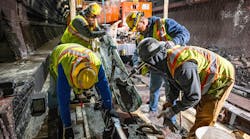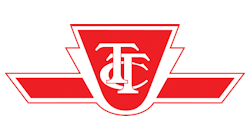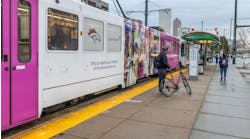The Massachusetts Bay Transportation Authority (MBTA) has completed critical track work on the Red Line while Toronto Transit Commission (TTC) has begun preventative maintenance work on isolated sections of subway tracks on Lines 1 and 2.
MBTA
While service was suspended in different areas between July 12 and July 28, MBTA crews were able to lift nine safety-related speed restrictions on the Red Line—two more than originally planned.
“I’m proud of the major infrastructure work our contractors and MBTA crews were able to accomplish, replacing over four miles of running rail on the Red Line and more,” said MBTA General Manager and CEO Phillip Eng. “Accomplishing this work, giving our riders a quicker and smoother trip, was the result of early planning and continuous coordination by the MBTA teams responsible for planning and performing this effort to reverse years of underinvestment. We have committed to our riders and the communities we serve that we would deliver safe, reliable and more frequent service, and section by section, we are doing just that.”
Crews accomplished the following work:
- Replaced 21,725 feet of rail
- Removed more than 30,000 feet of scrap rail from within the tunnels
- Replaced approximately 1,700 feet of restraining rail
- Replaced 250 crossties
- Resurfaced and tamped nearly 11,500 feet of track
- Replaced more than 2,600 tie plates
- Replaced 21 primary floating concrete slabs and 25 secondary floating concrete slabs
- Replaced 50 WeeZee bonds, which are part of the track circuit’s infrastructure
- Repaired or replaced 16 track bonds due to damage
- Removed and reinstalled approximately 4,500 feet of balancing cable by the Signal Department
- Replaced and fully tested approximately 55 individual track circuits
- Replaced and fully tested 10 track circuit loops
- Installed cable hanger assemblies in the northbound tunnel from Alewife to Harvard for nearly 13,000 feet.
- Replaced approximately 5,000 square feet of the roof of Alewife’s east headhouse
- Gauged about 2,000 of feet of Red Line track, including curves and at crossovers, by the Maintenance of Way team
Crews also maximized the outage by performing signal work and station amenity upgrades, including new lighting, painting, tiling, power washing and more.
TTC
TTC is working to repair minor track issues on Lines 1 and 2 throughout the summer and fall after regular track inspections found the spots in need of repair. According to the TTC, the proactive approach the agency is taking to fix the sections allows it to address potential issues before they escalate into more serious disruptions and to ensure the ongoing safety and dependability of subway service.
TTC notes trains are running at reduced speeds at isolated points where maintenance work is taking place, resulting in longer than normal travel times for some customers. In the Restricted Speed Zones (RSZs), trains are travelling between 15 and 25 kmh (9.3 mph and 15.5 mph), compared to normal operating speeds of 40 to 60 kmh (24.9 mph to 37.3 mph). As of July 30, TTC notes there were 34 RSZs in place, with most zones ranging from 500 to 1,000 feet in length.
In May, the TTC conducted a comprehensive survey using predictive rail maintenance technology, which identified multiple points where track geometry, such as rail gauge and wear, was outside the TTC’s acceptable standards.
The TTC is leveraging existing state-of-good-repair projects and scheduled weekend closures in July, August and September to expedite repairs and minimize disruptions. The planned closures allow maintenance crews to work efficiently and effectively to complete necessary repairs on both Line 1 and Line 2. Work is also carried out after service concludes each night.

Brandon Lewis | Associate Editor
Brandon Lewis is a recent graduate of Kent State University with a bachelor’s degree in journalism. Lewis is a former freelance editorial assistant at Vehicle Service Pros in Endeavor Business Media’s Vehicle Repair Group. Lewis brings his knowledge of web managing, copyediting and SEO practices to Mass Transit Magazine as an associate editor. He is also a co-host of the Infrastructure Technology Podcast.




